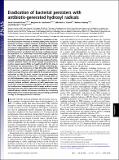The eradication of bacterial persisters with antibiotic-generated hydroxyl radical
Author(s)
Haseley, Nathan Scott; Grant, Sarah Schmidt; Kaufmann, Benjamin B.; Chand, Nikhilesh S.; Hung, Deborah T.
DownloadGrant-2012-Eradication of bacte.pdf (245.2Kb)
PUBLISHER_POLICY
Publisher Policy
Article is made available in accordance with the publisher's policy and may be subject to US copyright law. Please refer to the publisher's site for terms of use.
Terms of use
Metadata
Show full item recordAbstract
During Mycobacterium tuberculosis infection, a population of bacteria likely becomes refractory to antibiotic killing in the absence of genotypic resistance, making treatment challenging. We describe an in vitro model capable of yielding a phenotypically antibiotic-tolerant subpopulation of cells, often called persisters, within populations of Mycobacterium smegmatis and M. tuberculosis. We find that persisters are distinct from the larger antibiotic-susceptible population, as a small drop in dissolved oxygen (DO) saturation (20%) allows for their survival in the face of bactericidal antibiotics. In contrast, if high levels of DO are maintained, all cells succumb, sterilizing the culture. With increasing evidence that bactericidal antibiotics induce cell death through the production of reactive oxygen species (ROS), we hypothesized that the drop in DO decreases the concentration of ROS, thereby facilitating persister survival, and maintenance of high DO yields sufficient ROS to kill persisters. Consistent with this hypothesis, the hydroxyl-radical scavenger thiourea, when added to M. smegmatis cultures maintained at high DO levels, rescues the persister population. Conversely, the antibiotic clofazimine, which increases ROS via an NADH-dependent redox cycling pathway, successfully eradicates the persister population. Recent work suggests that environmentally induced antibiotic tolerance of bulk populations may result from enhanced antioxidant capabilities. We now show that the small persister subpopulation within a larger antibiotic-susceptible population also shows differential susceptibility to antibiotic-induced hydroxyl radicals. Furthermore, we show that stimulating ROS production can eradicate persisters, thus providing a potential strategy to managing persistent infections.
Date issued
2012-07Department
Harvard University--MIT Division of Health Sciences and TechnologyJournal
Proceedings of the National Academy of Sciences of the United States of America
Publisher
National Academy of Sciences (U.S.)
Citation
Grant, S. S. et al. “Eradication of Bacterial Persisters with Antibiotic-generated Hydroxyl Radicals.” Proceedings of the National Academy of Sciences 109.30 (2012): 12147–12152. © 2013 National Academy of Sciences
Version: Final published version
ISSN
0027-8424
1091-6490